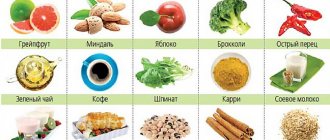A tale about basal metabolism. I made a calculator in which you can calculate the norm and level of basal metabolism. You will learn the extreme minimum of calories, followed by exhaustion and much more interesting things. Go!
“There is nothing more dangerous than experiments on your body,” stated Ivan Tsarevich, picking his teeth with a rusty needle. “Neither an egg, nor a duck, nor a hare will help.” Old Koschey tormented himself. And he kept repeating: “I eat according to science, I count calories!” Poor fellow! “Bury him, guys,” he commanded the gravediggers...
Hello friends! Basal metabolism, what it is, is not clear to everyone the first time. The topic, however, is not just vitally important, but glaring. And it has matured in our time, when the passion for diets and the desire to lose weight to the point of a skeleton has become overgrown with advertisements, most of which are murderous and cause irreparable harm. But first things first…
Friends, read the article further, there will be a lot of interesting things in it!
And for those who want:“KNOW THE DEGREE OF SLUGGING IN YOUR BODY”
Take a TOXIN TEST .
What is basal metabolism?
Such physiological processes support the vital functions of the body.
A significant portion of the energy released as a result of metabolic reactions of the basal type is spent on:
- heartbeat;
- respiratory activity;
- functioning of the endocrine glands;
- thermoregulation;
- digestion;
- work of the hepatobiliary mechanism;
- renal activity.
Basal metabolism is the main material metabolism determined during the period of wakefulness, with muscular and emotional rest, a comfortable ambient temperature within the range of +18...+22°C.
The transformation of endogenous compounds and nutrients is a constantly occurring biochemical change in a living organism, affecting tissue structures, cells, and biological fluids.
The key goal of basal metabolism is to process food into the energy necessary to maintain life.
During basal metabolism:
- protein and other proteins are synthesized;
- fats are broken down;
- carbohydrates are released;
- some amino acids are produced;
- Nitrogen waste, which is a by-product of such physiological reactions, is removed.
Basal type metabolism can be primary or secondary. Each has its own complex purpose. Primary metabolic reactions are aimed at carrying out basic biochemical reactions.
They determine the development, vital activity and growth of the body.
Basal Metabolism
As a result of such processes, the following are produced:
- saccharides are the main source of energy;
- lipid substances that form the basis of subcutaneous tissue, the protective capsule of some vital internal organs;
- amino acids;
- nucleic substances that store, transmit and implement genetic information.
Secondary basal metabolism - biochemical reactions in individual structural groups.
They are aimed at the production and breakdown of specific substances of non-protein nature:
- immunocompetent compounds;
- hormones;
- pigments;
- building molecules that form the skeletal frame, hair, nail plates.
The rate at which food is converted into energy is called the metabolic rate. This indicator is individual. It depends on the functioning of the nervous system and the endocrine mechanism, the current state of the internal organs.
Determination of basal metabolic rate and resting metabolic rate
Many weight loss and exercise guides use the terms basal metabolic rate and resting metabolic rate (RMR) interchangeably.
The point is that these two terms are very similar. But there is a slight difference in the definition of BMR and RMR that is useful to understand. Measuring the number of calories needed to perform the most basic ( basic
) your body's functions such as breathing, blood circulation and cell production. BMR is most accurately measured in a laboratory setting under very limited conditions.
Why is it necessary to calculate the basal metabolic rate (BMR)?
Such calculations are important for determining the number of calories burned daily at rest, emotional stress, and physical activity. The calculation is used by athletes and representatives of various sports. Determination of UMR is necessary for the treatment of metabolic disorders.
The technique is used for figure correction in cases of morbid obesity. Knowing your own basal metabolic rate is important for creating a diet, increasing muscle mass, and acquiring the desired anthropometric parameters.
To maintain optimal body weight based on the BMR calculation, consume the same amount of calories as burned.
Basal metabolism provides:
- hormonal synthesis;
- secretion of enzymes;
- cognitive functions;
- falling asleep;
- immune support;
- the correct proportion of anabolic reactions and catabolic processes.
In case of such violations, the UMR indicator is used to draw up effective therapeutic tactics and determine a treatment plan. Basal metabolism is regulated by the hypothalamus.
Calculation of the rate of metabolic reactions is performed when diagnosing functional disorders of this part of the cerebral zone. The indicator is distinguished by phenotypic flexibility.
The function can be reversibly regulated with medications and physiotherapeutic methods. The rate of metabolic reactions is influenced by endogenous and exogenous factors.
Basal metabolic processes are accelerated in certain pathological conditions:
- elevated body temperature;
- burn injuries;
- bone fractures;
- infectious and inflammatory processes;
- fever.
BMR changes depending on the phase of the menstrual cycle, at different periods of pregnancy. Calculation with the necessary adjustments is used to determine the cause of sudden weight loss or, conversely, abnormally rapid weight gain.
How to change your basal metabolic rate?
A combination of factors determines your basal metabolic rate. Genetic factors, age, gender and body composition play a role. There is little you can do to control genetics, age or gender. But you can change your body composition to boost your metabolism.
So how can you change your basal metabolic rate?
Build muscles!
Even when your body is at rest, muscle mass burns more calories than fat. And you don't even have to be a bodybuilder to see the benefits. Several studies have shown that after just a few weeks of resistance training, you can see a 7-8% increase in resting metabolic rate.
Norm depending on age group and gender
Basal metabolism is an indicator of the rate of basic material metabolism, which is considered a constant value for each organism under conditions of complete rest and comfortable temperature.
UMR serves as an integral value of the intensity of redox reactions in tissue and cellular structures. The norm depends on the type and nature of the external influence on the body.
The level of basal metabolism changes with excessive or excessive saturation of the body with food products and physiologically active substances. The speed of such processes is influenced by physical activity and climatic factors.
BMR depends on gender, age, and functional state of the body. The approximate daily calorie consumption for an adult is estimated at 1600-1700 kcal.
Approximate basal metabolic rate indicators for adults of different ages and gender are presented in the table.
| Age, years | Standard basal metabolic rate, kcal per 1 m2 of body area per hour | |
| Men | Women | |
| 16-18 | 43,0 | 40,0 |
| 18-20 | 41,0 | 38,0 |
| 20-30 | 39,5 | 37,0 |
| 30-40 | 39,5 | 36,5 |
| 40-50 | 37,0 | 35,5 |
| 50-60 | 35,3 | 32,7 |
In children under 16 years of age, the basal metabolic rate is unstable and subject to significant fluctuations under the influence of numerous factors. The daily calorie requirement of infants, according to various research data, is 46-54 kcal/kg body weight.
In the first months of life, the mechanism of thermoregulation is actively formed, requiring an increased amount of energy. Heat production constantly increases, reaching its maximum value at the beginning of the second year after birth.
During this period, the child’s thermoformation exceeds that of adults by 1.5-2 times. In different life phases, basal metabolism either accelerates or slows down. As the body develops, the basal metabolism stabilizes and at the age of 16 years it reaches standard values characteristic of adults.
The increased rate of metabolic processes in children is due to a large volume of protoplasmic mass, significant reaction activity, and rapid growth of skeletal structures and tissue structures.
My tips and recommendations for good metabolism
- Proper healthy eating + calorie tracking (food intake tracking)
- Active and active lifestyle in general
- Physical activity in the gym
- Control % body fat (muscle/body fat ratio)
- Elimination of bad habits (alcohol, cigarettes, etc.)
- Elimination of stress (+high-quality recovery, including healthy 8-hour sleep)
- Control of the hormonal system and overall health...
- Avoid long-term low-calorie diets
- No strict diets (sharp restrictions on food, calories)
How to measure BMR?
Minimal neural activity is required to obtain a reliable and objective laboratory value. The subject is immersed in a state of complete rest. For the calculation, a specially developed Harris-Benedict, Mifflin-San Jeor or Kutch-McArdle formula is used.
The first one was developed in 1984 by an American physiologist and nutritionist, after whom it is named. In 1990, a more accurate and up-to-date formula for calculating basal metabolic rate was introduced. Its authorship belongs to a group of American nutritionists, led by Doctors Mifflin and Saint-Jeor. This formula is considered the most accurate.
The Kacha-McArdle scheme appeared relatively recently. Its difference from other used formulas lies in the possibility of calculating the body’s energy expenditure during sleep. It takes into account the volume of muscle mass and the activity of muscle structures in an unconscious state. The technique is suitable for professional athletes. Basal metabolism slows with age and as lean body mass decreases.
Strength and aerobic exercises significantly increase the body's energy consumption. The Kutch-McArdle formula allows you to accurately calculate this indicator. Graphically it is written as follows: BMR=370+21.6 (1-F) x W.
The letter F means the percentage of body fat from the total body weight, W – weight in kg. The updated Harris-Benedict equation for calculating basal metabolic rate in men is as follows: BMR=13.397xW+4.799xH-5.667xA+88.362.
The letter H is height in cm, A is age. The formula for women differs in the coefficients entered, but not in the calculation principle. It looks like this: BMR=9.247xW+3.098xH-4.330xA+447.593.
Basal metabolic rate can be calculated using the Mifflin-St. Jeor formula. This equation is used to determine daily calorie needs. The formula for men is as follows: BMR=10xW+6.25xH-5xA+5. The equation for women differs only in the last numerical factor. It has a value of -161.
Should you follow strict diets?
Using the proposed recommendations, you can significantly speed up the metabolic processes in your body. Accordingly, you don’t have to torture yourself with strict diets. In addition to psychological difficulties, there are very negative consequences in refusing food. By fasting, you may be able to lose a few pounds, but you risk losing muscle mass. This is what will lead to less calorie burning. Returning to your usual amount of nutrition, you will again gain the hated kilograms, and restoring muscle mass will not be so easy. Not to mention the fact that during a strict diet, the body does not receive enough nutrients, vitamins and acids necessary for normal functioning.
Basal metabolic rate calculator based on gender, age and weight
About 70% of the energy obtained from food is consumed by vital physiological processes. About 20% comes from nervous activity and physical activity.
The remaining 10% consume postprandial thermogenesis reactions associated with the digestion, breakdown and absorption of food. All of these metabolic reactions require oxygen and coenzymes.
In relation to the level of basal metabolism, a significant share of energy resources is spent on enzymatic processes, regulation of osmotic pressure in tissues and bloodstreams.
An energy resource is needed to evacuate carbon dioxide released as a result of the Krebs cycle.
The UBM calculation calculator takes into account the following factors:
- The initial rate of metabolic reactions. The indicator is unchanged for an individual organism. It is determined by the ratio of mobility to the excess amount of energy released.
- Saturation of blood with hormonal substances. With diabetic pathology or dysfunction of the gastrointestinal tract, the basal metabolism proceeds more slowly than the established norm.
- Gender. In men, metabolic reactions occur faster than in women, due to a larger volume of muscle tissue and less fat. Testosterone gives a 10% increase in speed. In women during the menopausal phase, the activity of the thyroid gland decreases, which causes weight gain. There is a hormonal imbalance that impairs the regulation of glucose, insulin, gucagon - catalysts of metabolic reactions.
- Body weight. A slender constitution speeds up the basic metabolism. Excess weight indicates slow metabolic reactions.
- Age. The natural slowdown in basal metabolism begins after age 40. At the age of 25, bone tissue growth stops. From this point on, the basal metabolic rate slows down by approximately 2% every 10 years.
In the formula for calculating the BMR, a coefficient of physical activity is introduced from 1.2 for a passive lifestyle to 1.9 for professional athletes.
How to calculate your basal metabolic rate?
To obtain objective and reliable results, it is necessary to accurately know many anatomical and physiological parameters. You can approximately calculate your own basal metabolic rate using a simple formula.
Basal metabolism is a physiological characteristic of the body that is subject to changes depending on:
- gender;
- age;
- body constitution;
- type of physical activity;
- presence of pathologies.
The formula for approximate calculation of the basal metabolic rate for an average 25-year-old girl weighing 50 kg and height 165 cm is as follows: 10.4x50+615x1.65-282.
According to the result, she needs to consume 1253 kcal daily to maintain normal functioning of the body. The above formula does not take into account the type of physical activity, individual endocrine activity, and hormonal levels.
A constant and personal parameter is food thermogenesis. About 10% of consumed energy resources are spent on its maintenance. Another important factor influencing BMR is the rate of breakdown of proteins, fats, and carbohydrate compounds.
The first ones are the most energy-consuming. Approximately 20-30% of their calorie content is spent on processing protein substances. For the absorption of carbohydrates, 6-8% is required, fats - 2-3%.
What matters is the type of food, which is taken into account in special formulas for calculating the UMR by assigning the appropriate coefficient. High-protein diets are used for figure correction due to the high energy costs of such substances.
In addition to high calorie consumption, such compounds instill a false sense of satiety, which makes it easier to adhere to the diet.
Lipid nutrients are divided into:
- saturated;
- polyunsaturated;
- monounsaturated;
- dietary cholesterol;
- trans fats.
Each variety requires its own amount of energy to process, which affects the basal metabolic rate. The accuracy of the calculation ensures an individual and multifactorial approach. Below are the current UBM calculation options.
Larne formulas
The calculation method takes into account the age category, which affects the rate of basal metabolic reactions. For men 18-29 years old, use the following Larne formula: 15.3 x weight in kg + 679. For women of the same age, only the coefficients change.
The calculation is made by multiplying body weight by 14.7. A coefficient of 496 is added to the result obtained. To calculate the level of basal metabolism in men aged 30-59 years, the body weight in kg is multiplied by 11.6 and added to the resulting numerical value of 879.
For women of the same age, the coefficients are 8.7 and 829, respectively. Such formulas are characterized by relative accuracy, since individual physiological and pathological factors that can change the rate of metabolic reactions within a significant range are not taken into account.
In clinical medicine, determining UBM has diagnostic value when choosing treatment tactics for numerous gastroenterological diseases, endocrine pathologies, and digestive disorders.
Nutritionists and doctors of other profiles use updated tables, which take into account the maximum number of factors, and correction factors apply. Additionally, calometric methods are used based on recorded gas exchange rates.
They make it possible to calculate and characterize energy losses with thermal effects characteristic of individual metabolic reactions reflecting the activity of organs, cytological units, and intracellular organelles.
Harris and Benedict formulas
Basal metabolism is a physiological characteristic, when calculating which it is necessary to take into account the type of physical activity. For such calculations, the Harris and Benedict formulas are used.
Each type of physical activity is assigned an individual coefficient by which the resulting BMR result is multiplied. For men, the following formula is used: 66.5 + (13.5 x weight in kg) + (5 x height in cm) – (6.75 x age).
When calculating the female level of basal metabolism, the first correction factor remains unchanged, the rest acquire values of 9.55, 1.8 and 4.7, respectively.
The result obtained reflects the approximate daily consumption of energy resources in calories. To clarify the BMR parameters, the calculated value is multiplied by an additional and independently determined coefficient of physical activity.
With a sedentary lifestyle, this figure is 1.2. For the average person, a coefficient of 1.375 is used. For those who go to the gym, go for daily morning jogs, or engage in heavy physical labor, it is recommended to multiply the result by 1.725.
Recommendation #1. Regular physical activity in the gym (required)
The muscles in the body are extremely important; The more muscles there are on the body = the more calories are required to provide them. Understand? Muscles consume energy. The more of them you have = the better the energy consumed is spent, the less you are susceptible to (a) accumulation of excess fat.
Therefore, your metabolic rate can be increased by actively building muscle mass.
And muscle mass can be obtained through active training in the gym + proper nutrition aimed at muscle growth + high-quality recovery.
In this regard, my training material will help you:
for men
for girls/women
Plus, the gym itself = efficient calorie burner.
Yes, those same calories that are responsible for the appearance of excess fat on the body.
That is, when doing strength exercises (that is, training, during training) = you spend energy, burn calories = accordingly, this helps you lose weight (burn fat).
But! That's not even the biggest plus. Gym workouts are, in fact, the most effective fat burning aides precisely because calorie (energy) consumption after strength training does not end immediately after the workout itself stops. Understand?
It continues even when you are no longer training.
Calories are burned further due to the energy that is needed to restore the muscles that you injured during training - with strength exercises. Understand?
In general, more about this here: “Strength training for weight loss.”
In addition to all this, muscles also create the beauty of bodily forms. Without them, your appearance will leave much to be desired. In general, be sure to use strength training in the gym.
Factors influencing UBM
In addition to the age, gender, and physiological reasons described above, the rate of basal metabolism is affected by a large number of behavioral, pathological, and genetic factors.
Meaning:
- Specific dynamic absorption of nutrients. Substances contained in food are usually broken down within 5-6 hours, but for each person this process has a different speed, which is reflected in the BMR indicator.
- Ambient temperature. Prolonged exposure to cold speeds up metabolic processes. When the temperature drops 10° below the established comfort level, the basal metabolic rate increases by 2.5%.
- Circadian rhythms. Basal metabolism changes depending on the time of day, days of the week, and seasons. During sleep, basal metabolism slows down by 13% compared to the waking period due to relaxation of skeletal muscles.
- Taking medications. The natural course of metabolic processes changes the consumption of diuretic medications, oral contraceptives, glucocorticosteroids, venotonic and many other drugs.
The tone of the autonomic and sympathetic parts of the nervous system has a significant influence on the rate of basal metabolism. The neurotransmitters they produce play an important role in thermogenesis. A pronounced change in the basal metabolism is observed with damage to the anterior lobe of the pituitary gland of the brain.
Pathological influence factors include tumor processes in chromaffin tissues. Such neoplasias secrete adrenaline and norepinephrine, which sharply accelerate the basal metabolism. A change in the UBM causes traumatic injury or tumor damage to the autonomic centers of the diencephalic zone.
Surgical amputation of the sympathetic plexuses and degeneration of the adrenal medulla lead to a decrease in the rate of basal metabolism. The hormones they secrete can affect not only the functions of internal organs, but also primary thermogenesis.
The biochemical mechanism of this effect is not fully understood. A change in the rate of basal metabolism leads to a violation of the production of thyroid hormone. This physiologically active compound performs specific regulation of tissue respiration and energy metabolism.
Obesity gene
A person has an obesity gene - obese gen. It is responsible for the synthesis of leptin protein by fat cells, which interacts with the receptors of the hypothalamus, the organ that regulates the activity of the endocrine system. Its mechanism of action is to transmit information about body weight and fat metabolism to the hypothalamus. The interaction of leptin with specific receptors located in the hypothalamic region activates the production of nerve impulses directed to the areas of the brain responsible for regulating appetite. In addition, the action of leptin stimulates the sympathetic nervous system, which in turn leads to an increase in blood pressure, heart rate and thermogenesis processes by uncoupling the processes of oxidation (cellular respiration) and phosphorylation (synthesis of ATP molecules) in the mitochondria of white adipose tissue. As a result of these processes, large amounts of energy that is stored in adipose tissue in the form of lipids can be converted into heat, which increases the body's energy expenditure at rest. The main effect of leptin is to suppress appetite. Leptin is synthesized by fat cells - adipocytes. The larger the fat cells in the human body, the more leptin they release into the blood. This causes the hypothalamus to suppress appetite to prevent a person from becoming obese. That is, normally, the fatter a person is, the less he should want to eat and the more intense his metabolism should be. However, studies have shown that obese people have 80% higher levels of leptin in their blood than people with a normal body fat percentage, and this does not make the former similar to the latter. In this case, there is a genetic defect in leptin receptors in the hypothalamus, which may result in low receptor sensitivity to this hormone. The body unsuccessfully tries to compensate for this by increasing the level of secretion of its own leptin, but stimulation of the hunger center continues even on a full stomach. When leptin receptors poorly perceive the body, the illusion of its low concentration is created. A low concentration of leptin serves as a signal of insufficient fat reserves in the human body, this includes mechanisms for increasing appetite and slowing down the rate of metabolic processes. That is why long-term dieting and fasting lead to an increase in appetite and a decrease in the effectiveness of losing fat reserves. A decrease in fat mass in the body also leads to a decrease in the concentration of leptin, which causes a protective reaction in the body. On a diet, this phenomenon is combated with the help of so-called loading days, that is, days when the level of carbohydrates increases several times.










